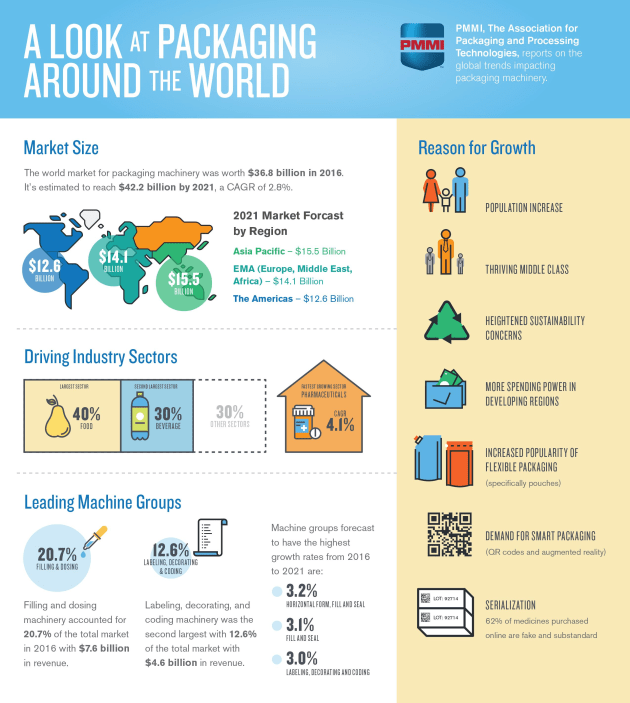The global market for packaging machinery will reach an estimated US$42.2 billion by 2021, with the Asia-Pacific region making up the lion’s share of that amount, according to a new report looking at global trends impacting the packaging machinery sector.
Global Trends Impacting the Market for Packaging Machinery 2018, a report by APPMA affiliate assocciation PMMI, the Association for Packaging and Processing Technologies in the United States, predicts that within three years, the APAC packaging machinery market will reach US$15.5 billion. The next biggest markets are Europe, Middle East and Africa (EMEA) at US$14.1 billion, and the Americas at US$12.6 billion, for a total of $42.2 billion – an increase of US$5.4 billion over 2016. This translates to a compound annual growth rate (CAGR) of 2.8 per cent.
According to PMMI, this is due to a number of factors: population growth and a thriving middle class, leading to more spending power in developing regions; heightened concern for sustainability; increased popularity of flexible packaging; demand for smart packaging incorporating elements such as QR codes and augmented reality; and serialisation for traceability.
The main industry sectors driving this growth are food at 40 per cent and beverages at 30 per cent; however, pharmaceuticals are the fastest-growing sector, with a CAGR of 4.1 per cent. This is of particular concern for track-and-trace systems, as the report found that 62 per cent of medicines purchased online are substandard counterfeits.
Counterfeiting is a significant challenge for the industry. According to PMMI’s Business Intelligence, Brand Protection and Product Traceability report in 2016, counterfeit goods were worth approximately US$1.5 trillion per year, a figure representing three to seven per cent of total world trade. The worldwide CAGR of the anti-counterfeiting market is between 12.8 and 16.7 per cent – a sign of how seriously the industry takes the problem of fake goods.
With US$7.6 billion in revenue, filling and dosing machinery was the leading machine group in 2016, accounting for 20.7 per cent of the total market. Labelling, decorating and coding came in second with US$4.6 billion in revenue, or 12.6 per cent of the market. The PMMI projects that the machine groups with the highest growth from 2016 to 2021 will be horizontal form, fill and seal at 3.2 per cent; fill and seal at 3.1 per cent; and labelling, decorating and coding at 3.0 per cent.
Flexible packaging is set to dominate growth in pack types, with the sector topping PMMI’s forecasts of absolute volume growth in the regions of Asia-Pacific, Western Europe, and Middle East and Africa. The report predicts flexibles will grow by 92 billion units in the Asia-Pacific region alone between 2015 and 2020, followed by PET bottles at 66 billion and glass bottles at 26 billion units.
The free executive summary of the Global Trends Impacting the Market for Packaging Machinery report can be viewed at https://www.pmmi.org/report/global-trends-impacting-market-packaging-machinery-2018.







